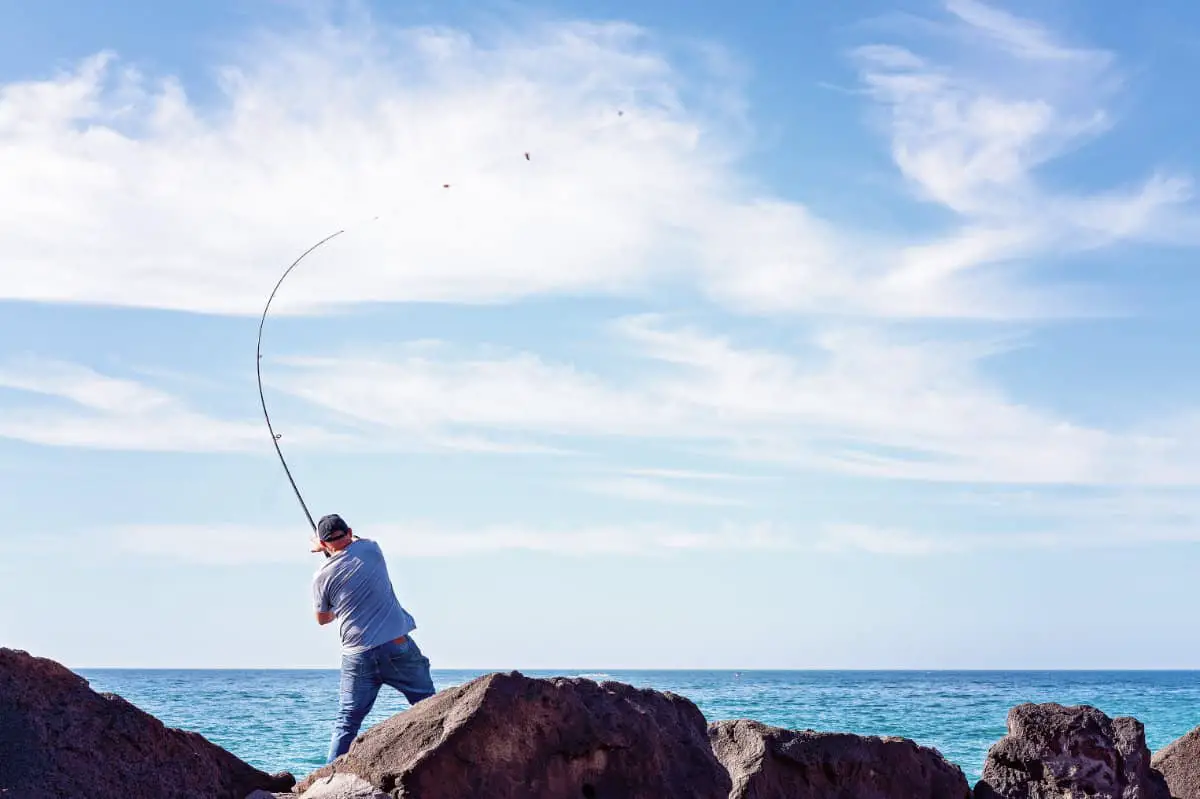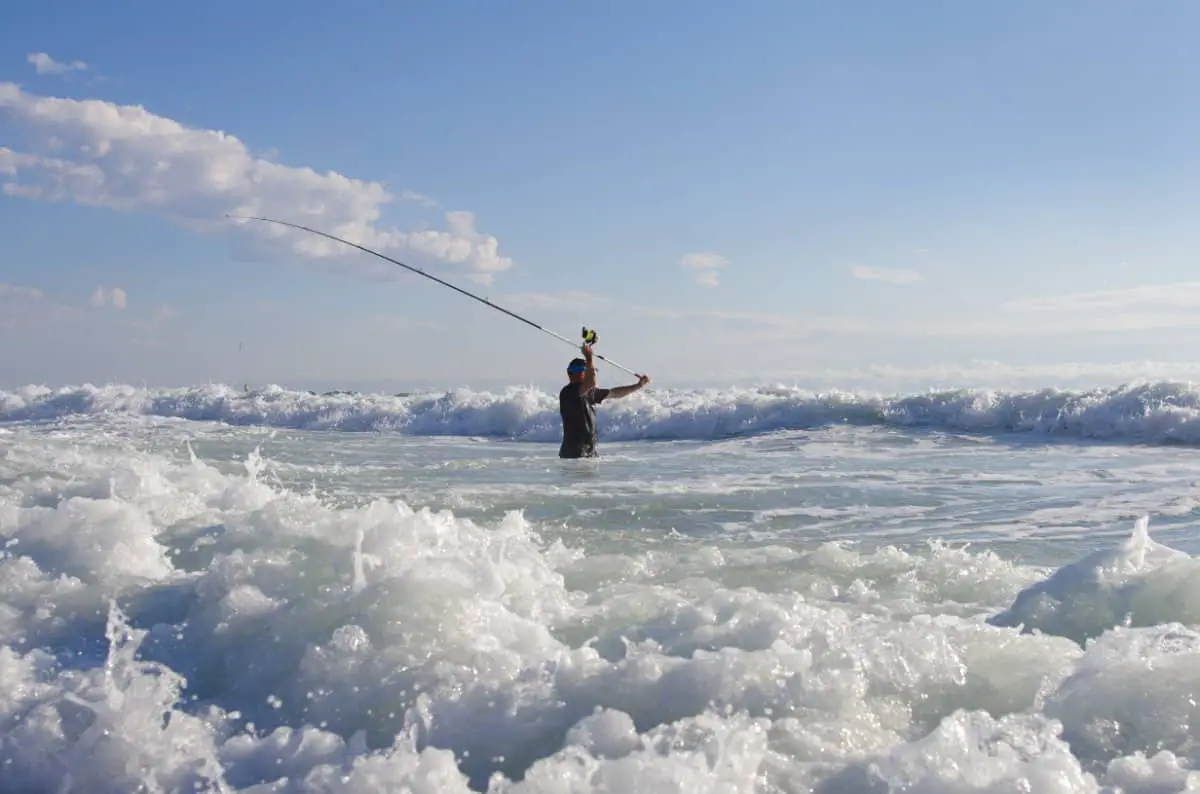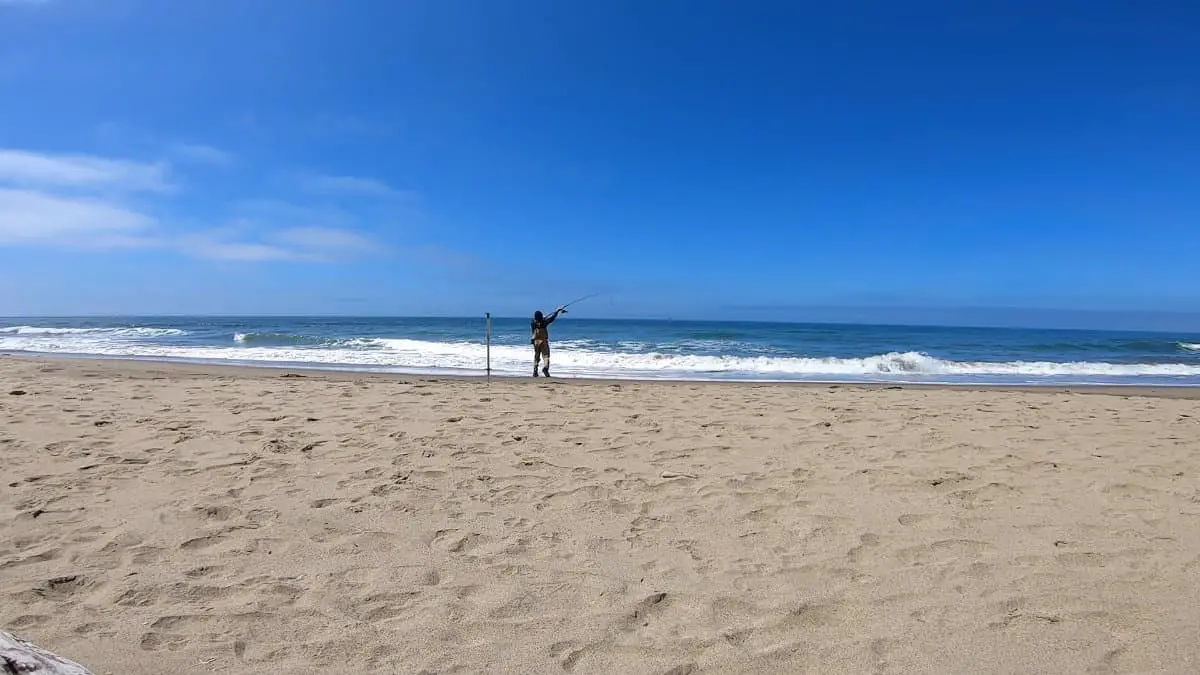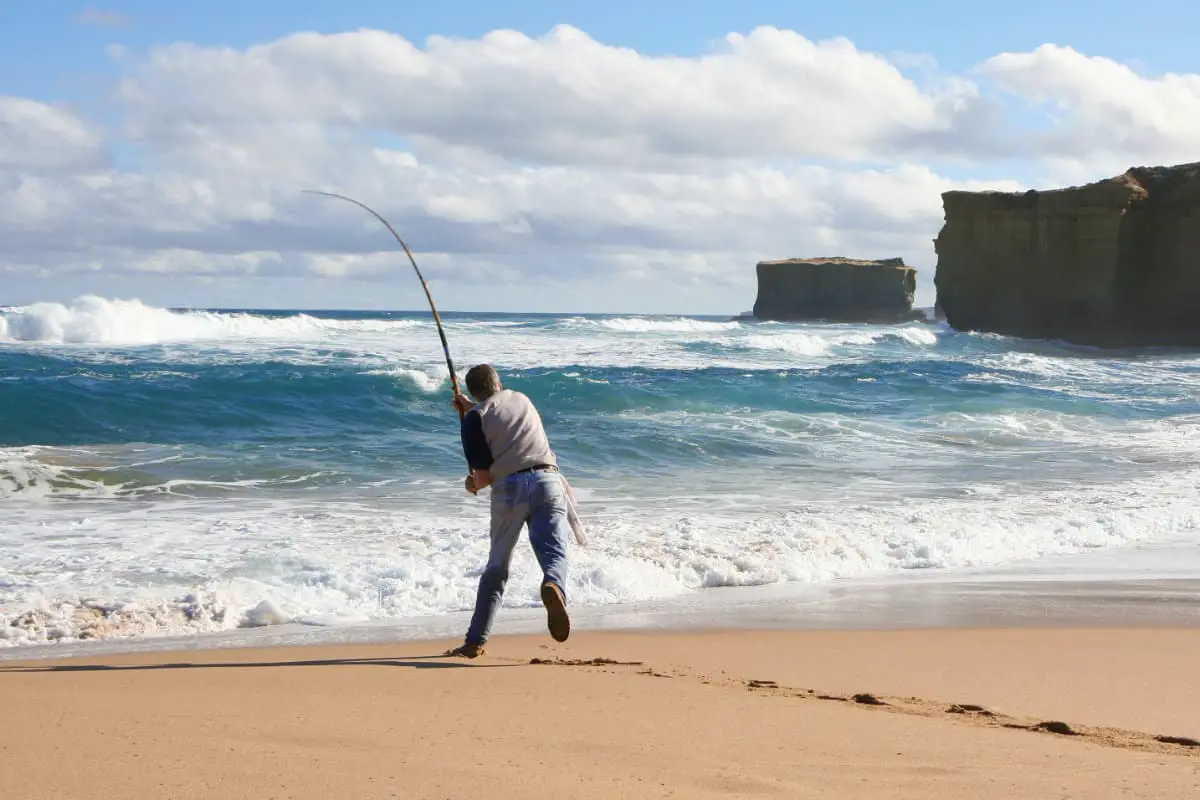A lot of anglers have difficulty casting at long distances when they first begin surf fishing.
The thing is surf fishing is a bit different. Frequently you want to cover a lot of water, something that you may have never needed to do before. Or at least not to that extent.
So, How to Cast further?
To cast your line further in surf fishing, you need first of all to master the pendulum cast technique. While using this casting technique, many anglers can cast at distances of 60 to 100 yards. Combining the right casting technique with an appropriate surf fishing tackle will allow you to cast even further.
I have been doing surf fishing for several years now, and the more I cast, the more I learn. Because let us be honest here, longer casts are always going to be impressive and awe-inspiring.
Below, I share with you all the things I have learned about how to improve your casts.
What Factors Influence Your Casting Distance While Surf Fishing?
There are going to be four main categories that will affect your casting distance. Some will have a more significant impact than others, and I will talk about that in a bit. For now, let’s take a look at what they are:
- The fishing tackle;
- The weather conditions;
- Personal capabilities; and
- Casting technique.
The first one – the fishing tackle – you will have the most and easiest control over. You can choose and alter your tackle almost on the go and as you see fit.
Unfortunately, the weather conditions are not that easy to control. It is quite the opposite. You have to adapt to them and try to go surf fishing during the most favorable times.
The casting technique is going to be the most crucial factor that will determine your casting distance. If you have a flawed method, even the best gear will not be able to help you. This is why I will be focusing on this a lot in this article.
And lastly, your capabilities are going to be another factor that will affect your casting abilities. Some of these you can change and others you can’t.
What Fishing Tackle Do You Need for Casting Further?
The Fishing Rod Power and Action
The action and the power of the rod are one of the first things that you need to take into consideration.
Usually, the best fishing rods for surf fishing![]() are with medium power and a medium action. But why is that?
are with medium power and a medium action. But why is that?
These usually provide the best versatility because they can hold more substantial weight and have some right snappy whipping action that creates more torque as you cast.
Fishing Rod Length
All other things equal a longer fishing rod will cast farther than a shorter one.
This is why the typical surf fishing rod![]() is on the longer end of the spectrum – usually between 10 to 14 feet.
is on the longer end of the spectrum – usually between 10 to 14 feet.
Fishing Line
Braided line will provide you with the best casting distance.
This is as a direct result of the smaller diameter it has compared to mono of the same class. The smaller diameter makes the braided line have a lot less resistance against the leaders, and it cuts through the wind and air with ease.
Another thing that can easily be overlooked is that you need the spool to be filled with a fishing line about 1/8 of an inch right up to the rim. This will reduce the resistance as the line unfolds and will give you longer casting distance.
You want just the right amount of fishing line because having too much line on your spool can result in wind knots also.
Lastly, do not go for a heavier test pound braided line than you need to. If you have been using 30-pound mono and you are moving to braided line, go for 30 test pound braided line as well.
If you go for a 60, 70, or even 80-pound test braided line, you will be defeating the whole purpose of the braided line as you will be fishing with a line that has the same thickness as mono.
Fishing Reel
Some of the best surf fishing reels are spinning reels![]() . They are easier to get the hang of and allow for longer casting distances.
. They are easier to get the hang of and allow for longer casting distances.
The more bearings the fishing reel has, the better, don’t forget that proper lubrication is also a must to provide for the smooth movement of the reel.
The spinning reels![]() are best for all anglers across the board – both experienced ones and beginners.
are best for all anglers across the board – both experienced ones and beginners.
You can also use a baitcasting reel, which can be a good choice as well. However, these reels are recommended for the more experienced anglers that already have mastered the spinning reels.
Baitcasting reels can be very finicky, and so they are not the best choice when you are first starting surf fishing.
Sinkers, Lures, and Baits

A heavy lure or weight is going to be a lot easier to cast at longer distances compared to a smaller one. The heavy lures, baits, or sinkers will add more momentum and driving force behind your cast.
That is true, of course, to a certain extent as at some point, the heavier the weight, the harder it will be to cast it.
Heavier weights will also have bigger resistance against the air. This will create more drag and will effectively shorten your casting distance.
Additionally, near the handle on most rods, you should be able to find the recommended fishing line test, lure, bait, and sinker weights that should be used with the fishing rod.
These should be appropriately matched. If they are mismatched, this can reduce your casting distance and can lead to line snapping and other unpleasant experiences.
And last but not least, when using lures, try getting yourself lures that have an aerodynamic-shaped body. That way, they will have less drag with the air when you cast them.
How Can the Weather Conditions Affect Your Casting Distance?
The weather conditions, good or bad, you cannot change. You can only try to adapt to or avoid to the best of your abilities.
When you are surfcasting![]() , you will almost always have to deal with some wind. In most cases, wind may not be a problem.
, you will almost always have to deal with some wind. In most cases, wind may not be a problem.
But ask anyone who has made the mistake of going surf fishing in a strong headwind, and they will tell you how ugly things can get. The wind, in this case, will cause more drag and severely impact your casting distance.
On the other hand, tailwind can add a few more feet to your cast, so there are always two sides to the coin.
How Your Physical Characteristics Affect Your Casting Distance?
Your body stature and characteristics, although overlooked, are another factor that will be affecting your casting distance potential, whether you like it or not.
Your Fitness Level
Even the lightest surf fishing rods![]() can start to tire you out. Especially if you like to wade into the water and cast often.
can start to tire you out. Especially if you like to wade into the water and cast often.
Your fitness and strength level is going to matter a lot. The longer you fish, the more strength and endurance you may need.
The fact that the rods are very long and the majority of anglers like fishing with big reels (think heavy reels) makes the matter even worse.
If you are into surf fishing and enjoy a pleasant and relaxing day at the beach while fighting fish, it may be just the right time to start hitting the gym every once in a while.
Your Height
Your height is something that you may not be able to change. Whether you are a good 6 foot something or a 5 foot 5, you are stuck with it.
When casting, it is all about the right leverage and angle. If you have shorter stature, you will be at a significant disadvantage over somebody who is much taller than you.
Imagine casting from a pier and the beach. Where will you be able to cast farther? The pier, of course.
Casting Techniques for Longer Casting

If you cannot cast more than say 20 feet, one of the first things you need to revise (before anything else) is your casting technique.
Frequently it is not going to be the gear that will be limiting your distance, but the actual casting technique. And let me tell you I have been there, and I know what it is alike.
It usually boils down to practice, practice, and even more practice.
This is especially true if you have been doing other kinds of fishing where you would not be casting very far away. Your body develops muscle memory with time, and it carries over to surf fishing.
You need to relearn how to cast, and it takes time, so be patient with yourself.
What Is the Typical Casting Distance for Surf Fishing?
Surf fishing and longer casting distances go hand in hand. This is why we typically use longer fishing rods.
Most of the anglers will try to cast as far as they can pass the breakers, but that is not always necessarily true. You can successfully fish from the beach while casting much, much closer.
The usual casting distance varies from 20 to 100 yards. And some people can get over way more than a hundred yards with ease.
And if that seems like a lot to you, don’t be too surprised as, even though that may not apply to real-life fishing conditions, some of the world tops can cast at distances of about 300 yards.
What Is the Best Casting Technique for Longer Casts?
One of the most frequent mistakes is not using both of your hands as you cast.
If you are fly fishing, you will most likely be good casting with one hand, but while surf fishing, and especially when aiming to cover more distance, you need to use both of your hands in tandem with your body and the fishing rod.
And this is what we will be talking about right now.
The best long-distance casting technique for surf fishing is known as the Pendulum Cast.
How to Do the Pendulum Cast
- Step One: Preparation
Keep one hand on the fishing rod’s butt and the other near or the real (if it is a conventional one).
Hold the rod behind you. You do not have to cast off the ground. But the fishing rod’s tip will probably be very close to the ground, and you want a 90-degree angle between the tip and the fishing line with the bait.
Keep your arms extended up and away from you.
The rod should be at a launch angle of about 45 degrees.
Don’t tuck your arms close to your body, and don’t hold them too tight. This will limit your range of motion and momentum.
It is almost as if you will be throwing a spear (with two hands).
- Step Two: Casting
As you cast, use your body and hips and legs to drive more momentum and energy and try to use the rod’s whipping action to add more power behind your cast.
Your whole body should be put to work as it drives the force – just like how a martial artist uses his entire body to punch harder. If your body is stiff and doesn’t move, there will be a severe lack of force.
Every fishing rod has a unique whipping action that needs time and practice to get a good hang of it. Take a look at this slow-motion video displaying correctly how a rod moves through space. It is all about physics.
That is going to be the most difficult part of the cast that takes the most time to learn. But this is the core thing that will add the most distance to your casts.
- Step Three: Release
Then as you release the fishing line, you need to add more power behind your bait or lure. As you extend your leading hand (Or the power hand – the one that holds the fishing rod near the reel), you bring down and pull back hard with your other hand that is holding the fishing rod near the butt.
This adds significantly more power to your cast and increases your casting distance. It should be a quick and snappy movement. This is a tricky movement to do, and it may take you some time mastering it.
After you release the line, hold the fishing rod at about a 45-degree angle.
If you want to take a good look at what some of the pro-long-distance casters do. Take a quick look at this video. It has some of the best and easy to follow tips for long-distance casting:
How to Practice Long-Distance Casting?
There is no substitute for real-life experience. So whenever you can go and practice on the beach.
Alternatively, you can practice in your backyard (the casting movement, not the release), given you have enough space.
You can also practice in a park or any open field where usually you should be able to cast as well. Be mindful of other people passing by as this may be dangerous, and you can hurt them.
You can use practice plugs and practice for as long as you can.
There is no magical shortcut. You can do it, all you need is the patience to learn how to.
For more detailed information and examples of how to practice your casting, take a look at this brief video:
Another thing you may want to try and do is get a camera (even the camera on your smartphone will be more than enough) and record yourself casting.
Regardless if it is the pendulum cast or any other technique you are using, recording yourself will be the best and easiest way to see if there are any flaws in your casting technique.
What Is the Ideal Casting Angle for Surf Fishing?
A lot of the beginner anglers may wonder about what the best casting angle for the best casting distance is.
Here we will be threading into the field of physics 101.
To find the best casting angle, we need to take a quick look into ballistics and projectile movement.
I will not be making this more complicated than it already is, and I will give you the answer.
The best angle that provides for the farthest casting distance of a projectile (think the bait or lure) is 45 degrees. So, what you want to do is develop the momentum. And release the fishing line when the rod is about 45 degrees about the ground.
This is why you will see that most surf fishers, as they cast, will kind of aim for the sky.
This can be useful; however, don’t get too hung up on the numbers. You can try to aim for that, but do not be overly concerned about whether or not you are hitting the right angle every time. Keep it simple.
A Few More Points on How to Improve Your Cast

Casting while surf fishing is a lot like riding a bike. You can have all the exact numbers and data backing you up, but until you hop on that bike, the numbers will not do anything for you.
Especially for beginners, it is essential to be patient and practice.
Practice a lot!
There is no way around that. It takes time for your body and brain to adapt and build the right neuron connections in your body and muscles.
Don’t get discouraged when you see somebody casting a hundred yards with ease. They have probably practiced for years before being able to pull it off.
Your body needs to be in the proper position and develop the correct movements and knows how to apply the power properly.
With this article, I have shown you the door. Now you all you have to do is walk through it.

